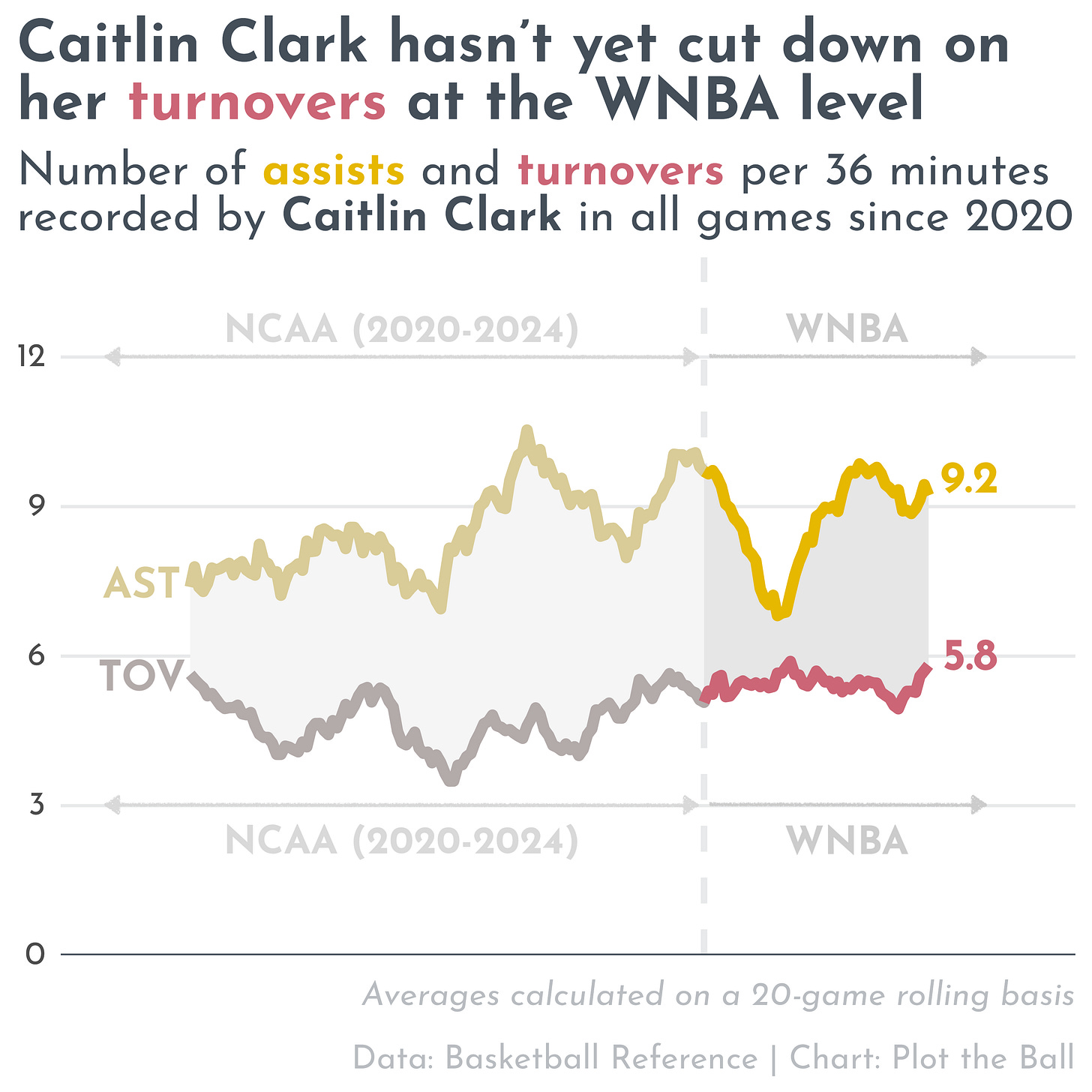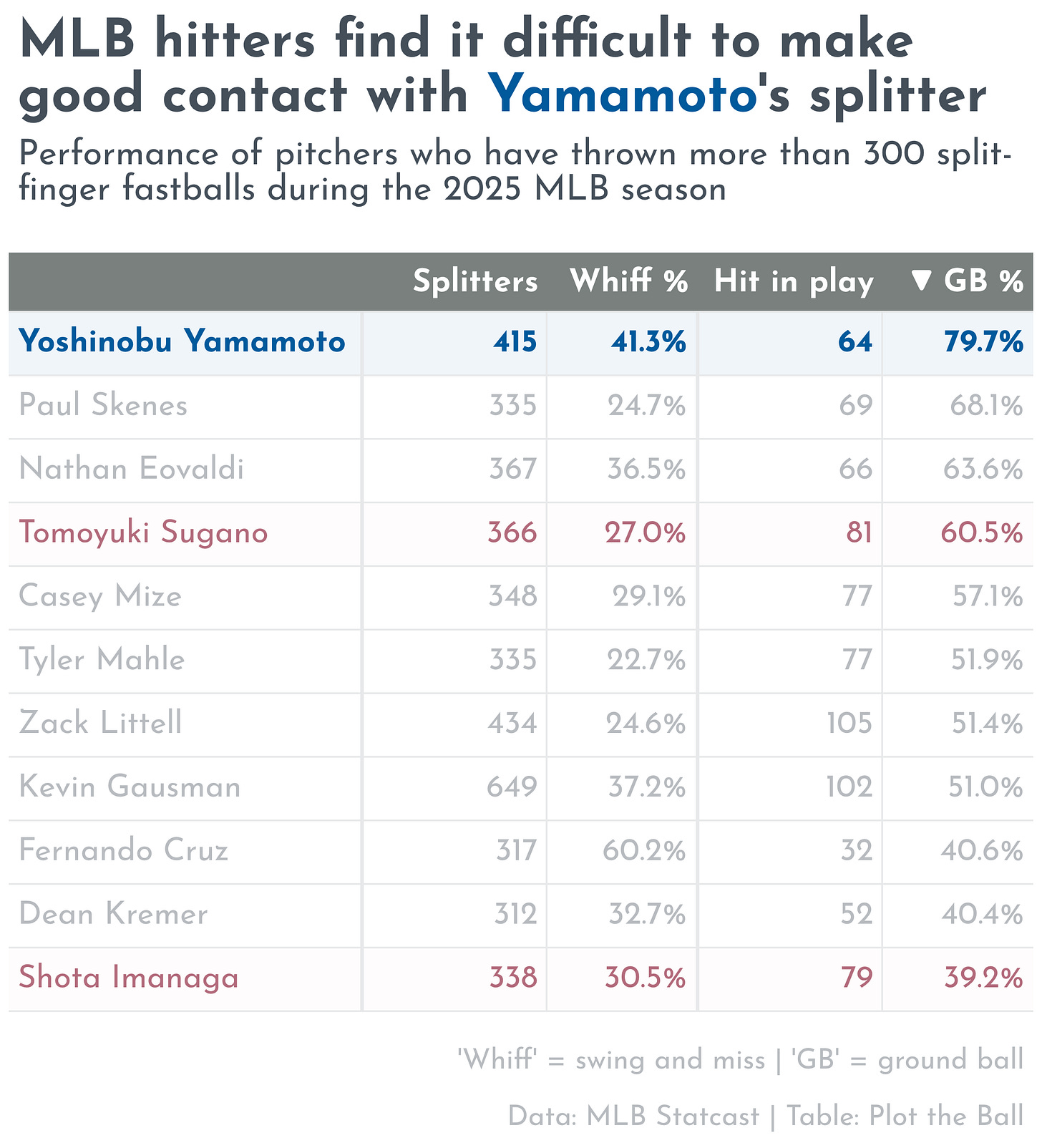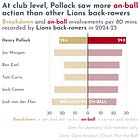🏀 Caitlin Clark’s first 50 WNBA games revealed her passing skill — and room for growth
My Week in Sport(s) 🏀 ⚾️ 🏏 ⛳️ 🏉
Welcome to My Week in Sport(s) — a regular newsletter from Plot the Ball.
Covered in this edition: 🏀 Caitlin Clark, ⚾️ Yoshinobu Yamamoto, 🏉 Joseph Sua’ali’i, 🏏 Sam Konstas and ⛳️ Jordan Spieth.
🏀 Caitlin Clark’s first 50 WNBA games revealed her passing skill — and room for growth
So far this year, things haven’t quite gone to plan for the Indiana Fever. While their underlying performances have improved from 2024, a defeat on Wednesday left them with a losing record as the WNBA season approaches its halfway point.
To be fair to the team, franchise cornerstone Caitlin Clark has missed nine of their 19 games due to injury. When Clark has played, though, it’s been clear that she’s not yet solved one of the most glaring weaknesses she had as a rookie: her tendency to turn the ball over to the other team. Clark was a high-turnover player at NCAA level with Iowa, too — but by the end of her college career she was compensating for those squandered possessions by frequently assisting her teammates’ shots.
When Clark got to the WNBA, those passing lanes immediately shut down. Over her last 20 games at Iowa, she recorded 9.7 assists per 36 minutes played; in her first 20 with the Fever, that figure dropped to just 7.3 — and the rate at which she turned the ball over remained fairly constant. She has found ways to open up those lanes again; over her last 20 WNBA games, Clark has averaged 9.2 assists per 36. Her turnovers, though, have been stubborn — and are actually trending upward to start 2025.
Adjusted for pace of play, Clark’s second year as a pro looks considerably worse than her first: she has committed 9.0 turnovers per 100 team possessions in 2025, up from 7.9 last year. It is worth noting that the Fever as a team haven’t been that wasteful with the ball; they were a slightly below-average team by overall turnover rate in 2024, and are in line with league average this year. It would be surprising — and a bit concerning for Indiana — if this area of Clark’s game didn’t improve over time, though.
For comparison, none of the league’s other top passers give the ball away anywhere near as much as she does. Four other active WNBA players have assisted more than 30% of their teammates’ made baskets while they’ve been on the floor, and not one of them has averaged more than five turnovers per 100 team possessions in their careers. Clark is already the WNBA’s most popular player; she will need to tidy up her playmaking if she’s truly to become one of the league’s best.
⚾️ Yoshinobu Yamamoto — like his compatriots — neutralises hitters with the best pitch in baseball
What distinguishes Japanese pitchers from their peers in Major League Baseball? Off the field, it’s the media circus that follows their every move — at least for the biggest names. On the mound, it’s their usage of one pitch: the split-finger fastball.
The splitter — which resembles a conventional fastball upon delivery, but drops out of the strike zone as it approaches the batter — is a valuable weapon in any pitcher’s arsenal. (Per David Adler: “[s]plitters had the lowest batting average and slugging percentage allowed last season of any pitch type.”) This year, it accounts for 22% of all pitches thrown by Japanese players; in aggregate, all other pitchers have thrown it just 3% of the time. Yoshinobu Yamamoto is among those to use it effectively.
What makes his splitter so good? So far in 2025, 11 players have thrown the pitch more than 300 times. Only one of them has made batters swing and miss at a higher rate than Yamamoto; no one else has induced ground balls — a poor outcome for a hitter if they make fair contact — anywhere near as frequently. He is pretty judicious in his deployment of the pitch, too. As a group, these 11 players have thrown the pitch around 28% of the time; Yamamoto’s splitter accounts for 26% of his pitches in 2025.
What else I learned last week
🏉 Joseph Sua’ali’i doesn’t yet have the kicking game to play fullback
Joseph Sua’ali’i looks set to start at outside centre in the upcoming series against the British and Irish Lions. Last year, he showed promising signs at the position for the Wallabies — but it’s not where he’s played the majority of his domestic rugby union.
Almost all of Sua’ali’i’s minutes for the New South Wales Waratahs so far have come at fullback. Why isn’t Australia head coach Joe Schmidt considering him there in international rugby? One obvious current limitation is his lack of a tactical kicking game. The 21-year-old averaged only 1.9 open-play kicks per 80 minutes across his starts in the 15 shirt during Super Rugby Pacific, according to Oval. In those same games, his opposite number at fullback kicked 4.7 times per 80 minutes on average.
🏏 Sam Konstas has started his test career in difficult circumstances
With an average of just 18 runs per dismissal in his first eight test innings, Sam Konstas is already facing scrutiny. Is the 19-year-old — who chanced his way to a memorable 60 on debut — really a future leader of the Australian batting order?
It’s early to be writing him off entirely, though — primarily because almost everyone has struggled to score runs in the games that he’s played so far. Players in the top three in Konstas’ four tests have averaged only 22; by my basic measure of batting performance, the young batter is scoring around four runs per dismissal below expectation. This is far from ideal, but it is better than a couple of Australia’s other openers in the WTC era — Joe Burns (-14) and Marcus Harris (-8) — have managed.
⛳️ Jordan Spieth’s best is no longer good enough to challenge at majors
Other than the obvious contenders, one of the first names I look for on any major-championship leaderboard these days is Jordan Spieth’s. The American has three majors to his name — all of them won in a three-year stretch between 2015 and 2017.
How far off the pace has Spieth fallen at golf’s biggest events? From 2015 to 2018, his performances were worth around 2.7 ‘expected wins’ at majors; over the seven seasons since, that figure is just 0.2 expected wins. The 31-year-old simply doesn’t produce top-quality weeks of golf any more, as Data Golf pointed out during this year’s PGA Championship: “the last time he gained 4 adjusted strokes/round (the minimum you need to have a realistic shot of winning a major) was…in 2021”.
The next edition of My Week in Sport(s) will be published on Friday July 18th.





